Why is the collector current at saturation less than the collector current in the forward active mode? Specifically,
Why is \$ I_C < \beta I_B \$ ?
Why is the collector current at saturation less than the collector current in the forward active mode? Specifically,
Why is \$ I_C < \beta I_B \$ ?
One way to look at this is, the BJT enters saturation when the supply is no longer able to provide enough current to keep it in forward active operation. For example, let's look at the basic common-emitter amplifier:

Let's say V273 is 5 V and R277 is 500 Ohm. Then if the base current were high enough that the forward active operating condition would give a collector current more than 10 mA, the collector would have to actually be pulled below ground (not indicated on the schematic, but let's say ground is the node connected to the emitter of the BJT).
To do this, the BJT would have to actually be delivering power to the rest of the circuit, which it simply can't do.
Of course, the BJT isn't even so close to ideal that it can pull the collector all the way down to ground, so saturation sets in at some higher collector voltage, which we normally take as about 0.2 V for typical silicon devices.